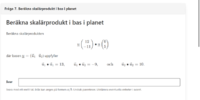Can someone explain this question? It seems easy but i've spent way too long on it.
∙ = dot product
calculate the scalar product of
u(9,1) ∙ u (6,0)
where the base u = (u1 u2) has the following criteria:
u1∙u1=18
,u1∙u2=−9,
u2∙u2=9.
The answer is 918
∙ = dot product
calculate the scalar product of
u(9,1) ∙ u (6,0)
where the base u = (u1 u2) has the following criteria:
u1∙u1=18
,u1∙u2=−9,
u2∙u2=9.
The answer is 918

